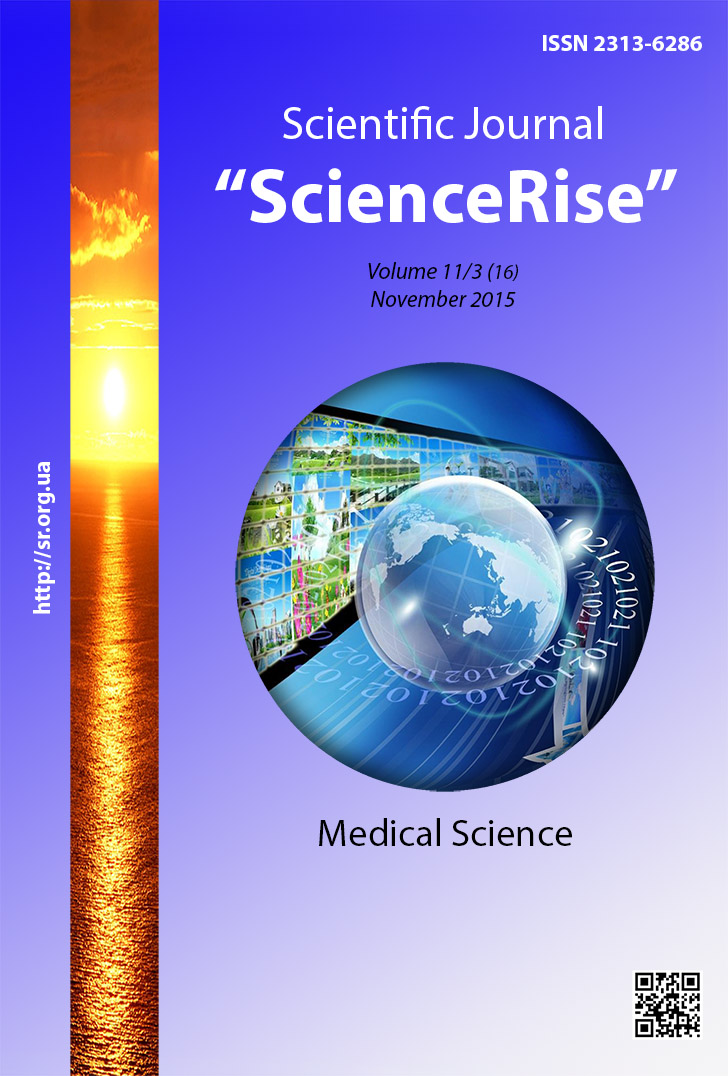Impact of new methods of respiratory support on postoperative restrictive syndrome and gas exchange after ventral hernias plasty
DOI:
https://doi.org/10.15587/2313-8416.2015.53823Keywords:
postoperative hypoxemia, atelectasis, recruitment maneuver, noninvasive pulmonary ventilation, ventral herniasAbstract
The concept of respiratory support in anesthesiology underwent significant changes for last decade. The aim of these changes was the decrease of frequency of postoperative pulmonary dysfunction development. In the research was considered an impact of the new strategies of respiratory support on the state of external respiration and pulmonary gas exchange in early postoperative period at large and giant ventral hernias plasty.
Methods. 77 patients underwent the prospective clinical examination after nonstrain methods of ventral hernias plasty. Patients receive the standard respiratory support in postoperative period, lung recruitment maneuver (RM) 40/10 and positive end-expiratory pressure (РЕЕР) 7–10 sm. water column, postoperative constant positive airway pressure (СРАР). There were studied the next parameters: oxygen saturation of arterial blood (SpO2), partial oxygen pressure in arterialized capillary blood (PaO2), gradient of carbon dioxide end-expiratory partial pressure in arterialized capillary blood (Р(а-et)CO2)), respiratory volume (RV), forced vital capacity (FVC)of lungs. The Kruskal-Wollis method with Mann-Whitney criterion assessment was used at intergroup analysis. Statistical analysis - STATISTICA AS for Windows (version 5.5).
Results. Statistical analysis demonstrated statistically significant (р<0,05) increase of oxygenation parameters (SpO2 , PaO2), spirogram parameters (RV, FVC), gradient decrease Р(а-et)CO2 in СРАР, RМ+СРАР groups in first 48 hours of postoperative period after large and giant ventral hernias plasty.
Conclusions. Postoperative СРАР and its combination with intraoperative RМ improve the state of oxygenation, decrease the restrictive syndrome in the first 48 hours after large and giant hernias plastyReferences
Coppola, S., Froio, S., Chiumello, D. (2014). Protective lung ventilation during general anesthesia: is there any evidence? Critical Care, 18 (2), 210. doi: 10.1186/cc13777
Hartland, B. L., Newell, T. J. Damico, N. (2014). Alveolar Recruitment Maneuvers Under General Anesthesia: A Systematic Review of the Literature. Respiratory Care, 60 (4), 609–620. doi: 10.4187/respcare.03488
Ireland, C. J., Chapman, M. T., Mathew, S. F., Herbison, G. P., Zacharias, M. (2014). Continuous positive airway pressure (CPAP) during the postoperative period for prevention of postoperative morbidity and mortality following major abdominal surgery. Cochrane Database of Systematic Reviews, 8. doi: 10.1002/14651858.cd008930.pub2
Gerbali, O. Yu. (2009). Legochno-plevralnyie oslozhneniya u bolnyih s osleoperatsionnyimi ventralnimi grizhami zhivota. Ukrainskiy zhurnal hirurgii, 3, 39-42.
Ferreyra, G., Long, Y., Ranieri, V. M. (2009). Respiratory complications after major surgery. Current Opinion in Critical Care, 15 (4), 342–348. doi: 10.1097/mcc.0b013e32832e0669
Thanavaro, J. L., Foner, B. J. (2013). Postoperative pulmonary complications. The Nurse Practitioner, 38 (7), 38–47. doi: 10.1097/01.npr.0000431179.49311.0b
Defresne, A. A., Hans, G. A., Goffin, P. J., Bindelle, S. P., Amabili, P. J., DeRoover, A. M. et. al (2014). Recruitment of lung volume during surgery neither affects the postoperative spirometry nor the risk of hypoxaemia after laparoscopic gastric bypass in morbidly obese patients: a randomized controlled study. British Journal of Anaesthesia, 113 (3), 501–507. doi: 10.1093/bja/aeu101
Tusman, G., Belda, J. F. (2010). Treatment of anesthesia-induced lung collapse with lung recruitment maneuvers. Current Anaesthesia & Critical Care, 21 (5-6), 244–249. doi: 10.1016/j.cacc.2010.07.007
Celebi, S., Köner, Ö., Menda, F., Omay, O., Günay, İ., Suzer, K., Cakar, N. (2008). Pulmonary Effects of Noninvasive Ventilation Combined with the Recruitment Maneuver After Cardiac Surgery. Anesthesia & Analgesia, 107 (2), 614–619. doi: 10.1213/ane.0b013e31817e65a1
Strang, C. M., Hachenberg, T., Freden, F., Hedenstierna, G. (2009). Development of atelectasis and arterial to end-tidal PCO2-difference in a porcine model of pneumoperitoneum. British Journal of Anaesthesia, 103 (2), 298–303. doi: 10.1093/bja/aep102
Downloads
Published
Issue
Section
License
Copyright (c) 2015 Ольга Миколаївна Павлова

This work is licensed under a Creative Commons Attribution 4.0 International License.
Our journal abides by the Creative Commons CC BY copyright rights and permissions for open access journals.
Authors, who are published in this journal, agree to the following conditions:
1. The authors reserve the right to authorship of the work and pass the first publication right of this work to the journal under the terms of a Creative Commons CC BY, which allows others to freely distribute the published research with the obligatory reference to the authors of the original work and the first publication of the work in this journal.
2. The authors have the right to conclude separate supplement agreements that relate to non-exclusive work distribution in the form in which it has been published by the journal (for example, to upload the work to the online storage of the journal or publish it as part of a monograph), provided that the reference to the first publication of the work in this journal is included.

